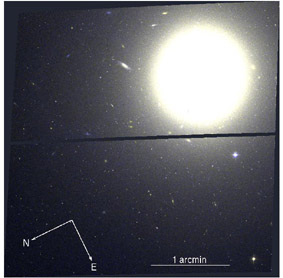SAO Research Highlights
Each edition of the SAO e-zine will feature a research highlight from one of the SAO teaching staff, either one of our instructors or project supervisors. This issue, Max Spolaor, an SAO project supervisor and current Swinburne PhD student, will discuss his work on observational clues from early-type galaxies to help constrain galaxy formation and evolution models. In the last three decades two main competing views on the star formation history of the early-type galaxies have been proposed: i.e. the monolithic collapse and the hierarchical merging models. In the former model, elliptical galaxies are formed by dissipative gravitational collapse of gaseous material created after the Big Bang. A galaxy can be assembled out of a unique cloud or many gaseous clumps, but not out of preexisting stars. All the galaxy stellar content is born at high redshift (z > 5) and on short timescales. On the other hand, in the latter scenario the formation of ellipticals is a hierarchical process of random mergers of late-type galaxies over a wide redshift range. Consequently, star formation activity and chemical enrichment are driven at each interaction, greatly affecting the stellar population of the finally formed elliptical galaxy. In particular, such a scenario agrees well with the modern adopted cosmological theory of structure formation dominated by cold dark matter. My approach to the problem of elliptical galaxy formation is to study their internal properties. To date, most stellar population studies focus on the central galaxy regions probing only a small fraction of the galaxy mass. For my PhD project I have recently obtained spectroscopic data out to large radii (and hence a large mass fraction) in a sample of early-type galaxies in environment of groups and clusters of galaxies. Observationally, we accomplished the task using the Gemini and Keck telescopes. The reduction and calibration of the data makes use of existing data reduction pipelines improved by ad hoc written software. Consequently, the combination of kinematics (velocity and dispersion) plus stellar populations (age, metallicity and alpha-element abundances) will provide a powerful probe of the dynamical and chemical enrichment history of such galaxies. Central values and radial trends will then be compared to predictions from galaxy formation models, placing the galaxies in the context of their environment. More recently, I'm finalising a similar study on the two bright early-type galaxies NGC 1407 and NGC 1400. These galaxies have long been studied because their puzzling situation; they lie in the same group, at the same distance (and therefore could be gravitationally bound), but have a remarkably different velocity. NGC 1400 is blueshifted by almost 1000 km/s respect NGC 1407 and the rest of the group galaxies. The hosted group is called NGC 1407 or Eridanus-A, and it is one of the 60 groups studied as part of the Group Evolution Multiwavelength Study (GEMS; a collaboration between the Centre for Astrophysics and Supercomputing and other international institutes), to understand the evolution of groups and member galaxies. |
 |
Right: NGC1407 and NGC1400 spectra adjusted to the rest frame. The shadow region indicate the central band of the Lick/IDS absorption spectral features used in the stellar populations analysis to derive age, metallicity and alpha-element abundances.







